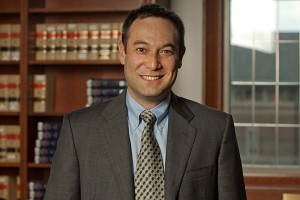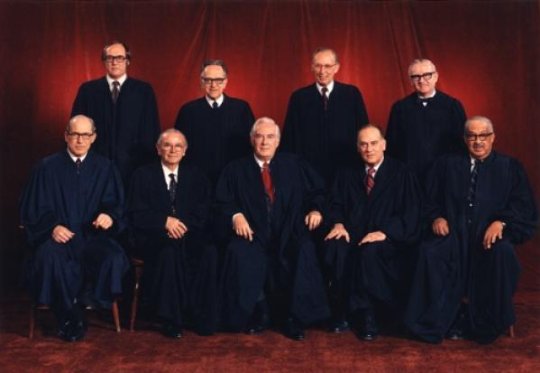On June 28, 1971, the Supreme Court ruled on Lemon v. Kurtzman in an 8–0 decision.
Alton Lemon, a social worker and civil rights activist in Philadelphia, served as lead plaintiff against the defendant, David Kurtzman, who served as Pennsylvania’s superintendent of public instruction.
At issue was whether a state using public taxes to fund certain aspects of religious education violated the Establishment Clause of the First Amendment to the United States Constitution (“Congress shall make no law respecting an establishment of religion”).
It was a landmark case, becoming one of the most highly cited cases in Supreme Court history. The controversial criteria, known as the “Lemon Test,” have been applied to prayer at graduation and other school functions, as well as the teaching of intelligent design in the classroom.
 In the conversation below, I talk to John Inazu—Associate Professor of Law and Political Science at Washington University in St. Louis and a Senior Fellow at the Institute for Advanced Studies in Culture at the University of Virginia. He teaches courses in criminal law, law and religion, and the First Amendment, and his scholarship focuses on the First Amendment freedoms of speech, assembly, and religion, and related issues of political and legal theory. His first book was entitled, Liberty’s Refuge: The Forgotten Freedom of Assembly (Yale University Press, 2012), and his most recent book, Confident Pluralism: Surviving and Thriving through Deep Difference, has just been published by the University of Chicago Press.
In the conversation below, I talk to John Inazu—Associate Professor of Law and Political Science at Washington University in St. Louis and a Senior Fellow at the Institute for Advanced Studies in Culture at the University of Virginia. He teaches courses in criminal law, law and religion, and the First Amendment, and his scholarship focuses on the First Amendment freedoms of speech, assembly, and religion, and related issues of political and legal theory. His first book was entitled, Liberty’s Refuge: The Forgotten Freedom of Assembly (Yale University Press, 2012), and his most recent book, Confident Pluralism: Surviving and Thriving through Deep Difference, has just been published by the University of Chicago Press.
In a ruling issued in June of 1971, Chief Justice Warren Burger devised what has come to be known as the “Lemon Test” to determine what counts as an unconstitutional “establishment” of religion. What is this test?
The Lemon test requires that a government law or regulation meet three qualifications:
(1) it must have a secular legislative purpose;
(2) its principal or primary effect must neither advance nor inhibit religious practice; and
(3) it must not result in an “excessive government entanglement” with religious affairs.
These three prongs are sometimes referred to as the Purpose, Effect, and Entanglement prongs.
Justice Antonin Scalia later wrote: “Like some ghoul in a late night horror movie that repeatedly sits up in its grave and shuffles abroad, after being repeatedly killed and buried, Lemon stalks our Establishment Clause jurisprudence once again, frightening the little children and school attorneys.” What did Scalia and others find so problematic about this formulation?
Justice Scalia may have been the most colorful critic of Lemon, but he was by no means the only critic. Judges and scholars have almost uniformly found Lemon to be unworkable.
One problem lies with the Purpose and Effects prongs. A smart legislator or judge can almost always identify some secular purpose to a law or regulation, and can almost always find some ways in which a regulation advances or inhibits religion. So we’re left with squishy judgments about how much of a purpose or how much of an effect.
The interaction of the Effect and Entanglement prongs has also led to what some scholars have called Lemon’s “Catch-22.” In order to ensure that the Effects prong has been met, government officials will need to investigate and probe the consequences of a law or regulation in a way that will often require careful monitoring and oversight. Those actions will in turn run afoul of the Entanglement prong, particularly given a strong presumption in American law that churches and religious institutions should be free from governmental mingling in their internal affairs.
The Supreme Court has long wrestled to identify alternatives to Lemon but has not yet agreed upon a workable solution. The closest it has come is an “endorsement” test proposed by Justice Sandra Day O’Connor and a “coercion” test formulated by Justice Anthony Kennedy. But each of these tests produces its own set of problems and ambiguities.
Some people may wonder why we’re concerned with these questions in the first place. After all, the First Amendment to the United States Constitution requires that “Congress shall make no law respecting an establishment of religion or prohibiting the free exercise therefore.” Doesn’t the Religion Clause simply mean that Congress (1) must not make laws concerning official or state churches and (2) must not prohibit or coerce religious expression.
That’s certainly a plausible interpretation of the First Amendment. This narrow reading of both establishment and free exercise is sometimes referred to as an attempt to avoid a “clash between the clauses.”
An alternative interpretation that seeks to maximize both establishment and free exercise leads to fun brainteasers like whether the Establishment Clause (which may demand nonpreferentialism for religion) prohibits the Free Exercise Clause (which may require preferentialism for religion). A more serious version of that tension has arisen in recent challenges asserting that religious freedom statutes violate the Establishment Clause on a theory of “third party harm.”
The First Amendment also contains a textual conundrum: the noun “religion” is the object of both the Establishment Clause (“no law respecting an establishment of religion”) and the Free Exercise Clause (“no law . . . prohibiting the free exercise thereof”). Some religious conservatives who want “religion” defined narrowly for free exercise purposes (to avoid protecting broader notions like “conscience”) thus need to account for the ways that the Establishment Clause constrains that narrow definition of religion. Conversely, some secular progressives who want free exercise interpreted broadly are stuck explaining why the Establishment Clause doesn’t also regulate expressions of conscience.
Some conservatives have charged that formulations like the Lemon Test go beyond the original meaning of the Establishment Clause. Are they right?
There’s a good argument to be made that the Establishment Clause originally constrained only the federal government, leaving the individual states free to decide whether or how to accommodate state-sponsored churches. From that baseline, much of contemporary doctrine goes beyond the original meaning of the Establishment Clause.
But the larger story is a bit more complicated. Most of the Bill of Rights originally applied only to the federal government, and courts and scholars today widely embrace its application to state and local laws. And while the Establishment Clause might plausibly have been treated differently, the Supreme Court has recognized its applicability to state and local laws since 1947. At this point in history, it would be hard to envision how to unring that bell.
In what sense is it helpful or unhelpful to think about religion in the Establishment Clause in terms of a “separation of church and state”?
Most current invocations of the phrase “separation of church and state” build upon the Jeffersonian metaphor of a “wall” of separation that demands vigilant policing. But neither our historical nor our contemporary practices justify such a line. The commingling of religious and political symbols—not to mention government dollars with private religious institutions—is simply too pervasive to resituate with some kind of doctrinal or theoretical purity. I think we’re better off with a more pragmatic approach that works to minimize incursions in either direction without aiming for unrealistic outcomes.
At the same time, I value the cautions raised in both directions. Jefferson worried about the church exerting too much control over the state, and long before him, the Baptist Roger Williams worried about the “wilderness” of the state corrupting the “garden” of the church. Both of these are real risks.
How does your vision of “confident pluralism” deal with related questions of religious liberty in a society that seems to be increasingly impatient with religious expression of deeply held commitments?
 My new book, Confident Pluralism, argues for greater tolerance, humility, and patience in our engagement across difference. There are plenty of places where Christians confront intolerant legal or cultural reactions to their beliefs and their way of life. It’s important that we articulate clear and compelling arguments that respond to these challenges.
My new book, Confident Pluralism, argues for greater tolerance, humility, and patience in our engagement across difference. There are plenty of places where Christians confront intolerant legal or cultural reactions to their beliefs and their way of life. It’s important that we articulate clear and compelling arguments that respond to these challenges.
At the same time, Christians who take seriously the idea of living peacefully with those who disagree with us cannot simply claim religious liberty when doing so is in our own interests. The policy implications of modern day Establishment Clause doctrine offer one area where we can demonstrate consistency in our views. Whatever the shortcomings of Lemon, and however far we may have traveled from the original meaning of the Establishment Clause, we ought to acknowledge the vast increase of religious diversity in this country. That includes the growing demographic of nonbelievers.
I’ve spoken with Jewish and atheist friends who grew up in era when Christian prayers were required in public schools. And I have non-Christian students who come from small Southern towns who assure me that these practices continue unabated in some schools, despite the Supreme Court’s holding to the contrary over fifty years ago. To my mind, a credible Christian witness in today’s pluralistic society would both acknowledge and accommodate the actual differences in our midst. If we’re going to make arguments for pluralism and difference in places where we don’t hold the political upper hand, we’d better be willing to make them in localities whose culture and politics continue to favor traditional Christianity. Otherwise, our arguments will rightly be judged as self-interested and hypocritical.



















